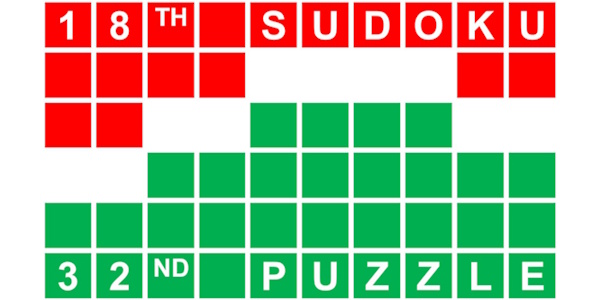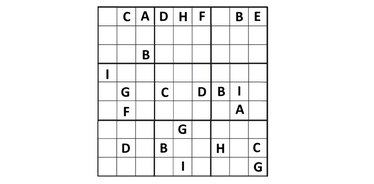O quebra-cabeça numérico Sudoku foi inventado pelo matemático suíço Leonhard Euler ainda no século XVIII, mas só ganhou popularidade nas décadas de 80–90 do século XX. O chamado "quadrado latino" ou "quadrado mágico" desenvolve a atenção, a lógica e o pensamento analítico. Além disso, é uma atividade útil para passar o tempo.
O Sudoku tradicional é um quadrado de 9x9, dividido em pequenos quadrados de 3 células de lado. Assim, todo o jogo ocorre em uma grade de 81 células. O jogo tem diferentes níveis de dificuldade, dependendo da quantidade de números preenchidos inicialmente e do método de resolução. A regra é simples: preencher os números nas células vazias da seguinte forma — em cada linha, coluna e quadrado menor, os números não devem se repetir.
Além do Sudoku clássico em uma grade de 9x9, há outras variações — de 4x4 até 25x25 células. Também existem versões com condições adicionais, regiões diferenciadas, formas geométricas diversas (não apenas quadradas) e outras. Vamos analisar algumas das variações mais populares.
Tipos de Sudoku
- Sudoku X
Esse tipo de jogo é um quadrado de tamanho NxN (normalmente 9x9) células. Este quadrado é composto por N (9) pequenos blocos, divididos em N (9) células. Alguns desses espaços já vêm preenchidos com números no início do jogo.
A tarefa do jogador é preencher as células vazias com números de 1 a N (9). Condição: em cada coluna vertical, linha horizontal e em cada bloco (9x9), cada número de 1 a N (9) deve aparecer apenas uma vez, sem repetições.
Além disso, as diagonais principais do Sudoku X também não devem conter números repetidos.
- Killer Sudoku
É basicamente uma combinação de dois tipos — “Sudoku” e “Kakuro”. Visualmente, o Killer Sudoku se parece com o clássico. Mas, diferente da versão tradicional, ele tem regiões adicionais onde a soma dos números deve ser igual a um valor indicado, como no Kakuro. Um dado importante na resolução é que a soma de todos os números de 1 a 9 sempre é 45. Isso ajuda a calcular com precisão os valores quando há várias regiões adjacentes preenchidas, exceto uma célula. Basta subtrair a soma das áreas preenchidas de 45 (ou de 90, 135 etc., ao considerar múltiplos grupos).
- Sudoku Par-Ímpar
Nessa variação, o jogador recebe informação sobre a paridade dos números nas células da grade. As células com números ímpares são marcadas com círculos.
Sua tarefa é preencher a grade com números de 1 a 9, seguindo a regra tradicional: cada linha, coluna e bloco deve conter cada número apenas uma vez.
- Sudoku com Pontos
Nessa variação, a grade possui pontos brancos e pretos nas bordas entre células. Um ponto branco indica que os números das células adjacentes diferem por 1. Um ponto preto significa que um número é exatamente o dobro do outro. Entre os números 1 e 2 (que satisfazem ambas as condições), pode haver um ponto de qualquer cor.
- Sudoku Quebra-cabeça
O Sudoku quebra-cabeça é um quadrado de tamanho NxN (geralmente 9x9). Ele é composto por N (9) blocos menores, cada um com N (9) células. Algumas células já vêm preenchidas com números.
O objetivo é preencher as células vazias com números de 1 a N (neste caso, 9). A condição é que, em cada linha horizontal, coluna vertical e bloco, cada número apareça apenas uma vez.
- Sudoku com Letras
Uma variação do Sudoku com números, onde a grade é preenchida com letras em vez de dígitos. Este tipo é chamado “Wordoku”. Participam 9 letras, como os 9 dígitos no Sudoku tradicional. A grade e as regras continuam as mesmas: cada linha, coluna e bloco 3x3 deve conter todas as letras sem repetições.
- Samurai
A variação chamada Sudoku Samurai consiste em cinco grades de Sudoku sobrepostas. As regras clássicas se aplicam a cada grade de 9x9. O objetivo do jogador é preencher todas as células com números de 1 a 9. Cada linha, coluna e bloco 3x3 não deve conter números repetidos.
A singularidade do Samurai Sudoku é que essas cinco grades não podem ser resolvidas separadamente — há uma única solução válida para todas elas ao mesmo tempo.
- Windoku
Nessa variação há blocos adicionais na grade, destacados por cor. Esses quatro blocos extras são chamados de “Janelas”.
Essas janelas se sobrepõem às linhas, colunas e blocos 3x3 padrão, tornando o jogo mais complexo. Além das regras clássicas, também é necessário garantir que cada uma das quatro janelas contenha os números de 1 a 9 sem repetições.
- Sudoku Maior-Menor
Mais uma modificação do Sudoku clássico. Aqui, a grade não possui números preenchidos inicialmente. Em vez disso, as células contêm sinais de comparação ">" e "<". Esses sinais indicam como os números nas células vizinhas devem se relacionar entre si.
- Sudoku Asterisco
Nessa grade existe uma área adicional destacada por cor, composta por 9 células, com forma de asterisco. Um asterisco é um símbolo tipográfico em forma de estrela (*). As células devem ser preenchidas com números de 1 a 9, conforme as regras clássicas do Sudoku.



